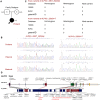A novel compound heterozygous variant in ALPK3 induced hypertrophic cardiomyopathy: a case report
- PMID: 37396576
- PMCID: PMC10311070
- DOI: 10.3389/fcvm.2023.1212417
A novel compound heterozygous variant in ALPK3 induced hypertrophic cardiomyopathy: a case report
Abstract
Background: Malignant hypertrophic cardiomyopathy (HCM) phenotypes have potential risks of severe heart failure, fatal arrhythmia, and sudden cardiac death. Therefore, it is critical to predict the clinical outcomes of these patients. It was reported recently that the alpha kinase 3 (ALPK3) gene was involved in the occurrence of HCM. Herein we reported a girl with HCM, while whole-exome sequencing found novel compound heterozygous variants in ALPK3 gene, which identified a potential association.
Case presentation: We reported a 14-year-girl who suffered from clinical manifestations of cardiac failure, with sudden cardiac arrest before admission. The heartbeat recovered after cardiopulmonary resuscitation, though she remained unconscious without spontaneous breath. The patient stayed comatose when she was admitted. Physical examination indicated enlargement of the heart boundary. Laboratory results revealed a significant increment of myocardial markers, while imaging demonstrated hypertrophy of the left heart and interventricular septum. Whole-exome sequencing (WES) identified a compound heterozygous variant in ALPK3 gene consisting of c.3907_3922del and c.2200A>T, which was inherited from her parents. Both variants (p.G1303Lfs*28 and p.R734*) were disease-causing evaluated by MutationTaster (probability 1.000). The crystal structure of the complete amino acid sequence is predicted and evaluated by AlphaFold and SWISS-MODEL software (July, 2022), which revealed three domains. Moreover, both variants resulted in a wide protein-truncating variant and damaged protein function. Thus, a novel compound heterozygous variant in ALPK3 associated with HCM was diagnosed.
Conclusion: We described a young patient with ALPK3-associated HCM who experienced sudden cardiac arrest. Through WES, we identified a compound heterozygous variant in the ALPK3 gene, c.3907_3922del and c.2200A>T, which were inherited from the patient's parents and resulted in a truncated protein, indirectly causing the symptoms of HCM. In addition, WES provided clues in evaluating potential risks of gene variants on fatal clinical outcomes, and the nonsense and frameshift variants of ALPK3 were related to adverse clinical outcomes in HCM patients, which required implantable cardioverter defibrillator (ICD) timely.
Keywords: ALPK3; case report; hypertrophic cardiomyopathy; novel variant; whole-exome sequencing.
© 2023 Li, Jin, Liu, Hua, Zhou, Luo, Li and Zhang.
Conflict of interest statement
The authors declare that the research was conducted in the absence of any commercial or financial relationships that could be construed as a potential conflict of interest.
Figures



Similar articles
-
Whole-exome sequencing identifies novel truncating ALPK3 variants in a compound heterozygous state associated with pediatric hypertrophic cardiomyopathy and phenotypic heterogeneity.Gene. 2025 Sep 5;963:149597. doi: 10.1016/j.gene.2025.149597. Epub 2025 May 28. Gene. 2025. PMID: 40447126
-
Spectrum and genotype-phenotype relationship of ALPK3 variants in Chinese patients with hypertrophic cardiomyopathy.Heliyon. 2024 Jun 10;10(12):e32786. doi: 10.1016/j.heliyon.2024.e32786. eCollection 2024 Jun 30. Heliyon. 2024. PMID: 39022049 Free PMC article.
-
The Involvement of ALPK3 in Hypertrophic Cardiomyopathy in East Asia.Front Med (Lausanne). 2022 Jun 15;9:915649. doi: 10.3389/fmed.2022.915649. eCollection 2022. Front Med (Lausanne). 2022. PMID: 35783621 Free PMC article.
-
[ALPK3 gene-related pediatric cardiomyopathy with craniofacial-skeletal features: a report and literature review].Zhonghua Er Ke Za Zhi. 2021 Sep 2;59(9):787-792. doi: 10.3760/cma.j.cn112140-20210222-00150. Zhonghua Er Ke Za Zhi. 2021. PMID: 34645221 Review. Chinese.
-
[A case of dilated cardiomyopathy caused by FHL2 gene variant and a literature review].Zhonghua Yi Xue Yi Chuan Xue Za Zhi. 2023 Mar 10;40(3):337-343. doi: 10.3760/cma.j.cn511374-20211230-01025. Zhonghua Yi Xue Yi Chuan Xue Za Zhi. 2023. PMID: 36854411 Review. Chinese.
References
-
- Elliott P, Andersson B, Arbustini E, Bilinska Z, Cecchi F, Charron P, et al. Classification of the cardiomyopathies: a position statement from the European society of cardiology working group on myocardial and pericardial diseases. Eur Heart J. (2008) 29(2):270–6. 10.1093/eurheartj/ehm342 - DOI - PubMed
Publication types
LinkOut - more resources
Full Text Sources

